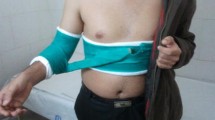Abstract
Purpose
This study aimed to evaluate the relationship between the extent of the labral lesion and the frequency of glenohumeral dislocation in patients with shoulder instability.
Methods
Ninety-three patients, who underwent surgical treatment at our clinic for chronic anterior shoulder dislocation, were selected and divided into 3 groups (group I: only Bankart lesion; group II: Bankart and SLAP lesions; group III: circumferential-labral lesion). The pre-operative frequency of dislocation, intraoperative findings, operation time, post-operative clinical score, and range of motion 2 years after surgery were analysed and compared among the 3 groups.
Results
The time interval from the initial dislocation to operation was significantly shorter in group III than in groups I and II (P = 0.034 and P = 0.046, respectively). The median number of preoperative dislocations was also significantly less in group III than in groups I and II (P = 0.025 and P = 0.044, respectively). In all groups, the clinical scores (Constant, Rowe, and visual analogue scale) improved significantly post-operatively, and there were no significant differences in the scores between the different groups. All patients returned to work, and most patients returned to their preoperative sports activity levels.
Conclusion
The extent of the labral lesion is not always related to the number of dislocations; therefore, treatment should not be based on this.
Level of evidence
Retrospective comparative study, Level III.


Similar content being viewed by others
References
Altchek DW, Warren RF, Wickiewicz TL, Ortiz G (1992) Arthroscopic labral debridement. A three-year follow-up study. Am J Sports Med 20(6):702–706
Antonio GE, Griffith JF, Yu AB, Yung PS, Chan KM, Ahuja AT (2007) First-time shoulder dislocation: high prevalence of labral injury and age-related differences revealed by MR arthrography. J Magn Reson Imaging 26(4):983–991
Bankart A (1938) The pathology and treatment of recurrent dislocation of the shoulder joint. Br J Surg 26:23–28
Brand RA (2008) Recurrent dislocation of the shoulder joint. Clin Orthop Relat Res 466:520–521
Burkhart SS, Morgan CD, Kibler WB (2000) Shoulder injuries in overhead athletes: the “dead arm” revisited. Clin Sports Med 19(1):125–158
Cofield RH, Irving JF (1987) Evaluation and classification of shoulder instability: with special reference to examination under anesthesia. Clin Orthop Relat Res 223:32–43
Dumont GD, Russell RD, Robertson WJ (2011) Anterior shoulder instability: a review of pathoanatomy, diagnosis and treatment. Curr Rev Musculoskelet Med 4(4):200–207
Garofalo R, Mocci A, Moretti B, Callari E, Di Giacomo G, Theumann N, Cikes A, Mouhsine E (2005) Arthroscopic treatment of anterior shoulder instability using knotless suture anchors. Arthroscopy 21(11):1283–1289
Gutierrez V, Monckeberg JE, Pinedo M, Radice F (2012) Arthroscopically determined degree of injury after shoulder dislocation relates to recurrence rate. Clin Orthop Relat Res 470:961–964
Habermeyer P, Gleyze P, Rickert M (1999) Evolution of lesions of the labrum-ligament complex in posttraumatic anterior shoulder instability: a prospective study. J Should Elbow Surg 8(1):66–74
Hantes ME, Venouziou AI, Liantsis AK, Dailiana ZH, Malizos KN (2009) Arthroscopic repair for chronic anterior shoulder instability: a comparative study between patients with Bankart lesions and patients with combined Bankart and superior labral anterior posterior lesions. Am J Sports Med 37(6):1093–1098
Koss S, Richmond JC, Woodward JS Jr (1997) Two- to five-year followup of arthroscopic Bankart reconstruction using a suture anchor technique. Am J Sports Med 25(6):809–812
Lo IK, Burkhart SS (2005) Triple labral lesions: pathology and surgical repair technique-report of seven cases. Arthroscopy 21(2):186–193
Maffet MW, Gartsman GM, Moseley B (1995) Superior labrum-biceps tendon complex lesions of the shoulder. Am J Sports Med 23(1):93–98
Milano G, Grasso A, Russo A, Magarelli N, Santagada DA, Deriu L, Baudi P, Bonomo L, Fabbriciani C (2011) Analysis of risk factors for glenoid bone defect in anterior shoulder instability. Am J Sports Med 39(9):1870–1876
Morgan CD, Burkhart SS, Palmeri M, Gillespie M (1998) Type II SLAP lesions: three subtypes and their relationships to superior instability and rotator cuff tears. Arthroscopy 14(6):553–565
Neviaser TJ (1993) The anterior labroligamentous periosteal sleeve avulsion lesion: a cause of anterior instability of the shoulder. Arthroscopy 9(1):17–21
Outerbridge RE (2001) The etiology of chondromalacia patellae. 1961. Clin Orthop Relat Res 389:5–8
Pagnani MJ, Deng XH, Warren RF, Torzilli PA, Altchek DW (1995) Effect of lesions of the superior portion of the glenoid labrum on glenohumeral translation. J Bone Jt Surg Am 77(7):1003–1010
Pappas AM, Goss TP, Kleinman PK (1983) Symptomatic shoulder instability due to lesions of the glenoid labrum. Am J Sports Med 11(5):279–288
Powell SE, Nord KD, Ryu RKN (2004) The diagnosis, classification, and treatment of SLAP lesions. Oper Tech Sports Med 12(2):99–110
Snyder SJ, Banas MP, Karzel RP (1995) An analysis of 140 injuries to the superior glenoid labrum. J Should Elbow Surg 4(4):243–248
te Slaa RL, Brand R, Marti RK (2003) A prospective arthroscopic study of acute first-time anterior shoulder dislocation in the young: a five-year follow-up study. J Should Elbow Surg 12(6):529–534
Tokish JM, McBratney CM, Solomon DJ, Leclere L, Dewing CB, Provencher MT (2010) Arthroscopic repair of circumferential lesions of the glenoid labrum: surgical technique. J Bone Jt Surg Am 92(Suppl 1 Pt 2):130–144
Yiannakopoulos CK, Mataragas E, Antonogiannakis E (2007) A comparison of the spectrum of intra-articular lesions in acute and chronic anterior shoulder instability. Arthroscopy 23(9):985–990
Acknowledgments
This work was supported by a research grant from Wonju College of Medicine, Wonju Christian Hospital, Yonsei University, Korea (YUWCM-2011-61). This study was approved by Ethical Committee Approval of Wonju College of Medicine, Yonsei University (Study number 2011-61).
Conflict of interest
None.
Author information
Authors and Affiliations
Corresponding author
Rights and permissions
About this article
Cite this article
Kim, DS., Yi, CH., Kwon, KY. et al. Relationship between the extent of labral lesions and the frequency of glenohumeral dislocation in shoulder instability. Knee Surg Sports Traumatol Arthrosc 21, 430–437 (2013). https://doi.org/10.1007/s00167-012-2045-z
Received:
Accepted:
Published:
Issue Date:
DOI: https://doi.org/10.1007/s00167-012-2045-z




